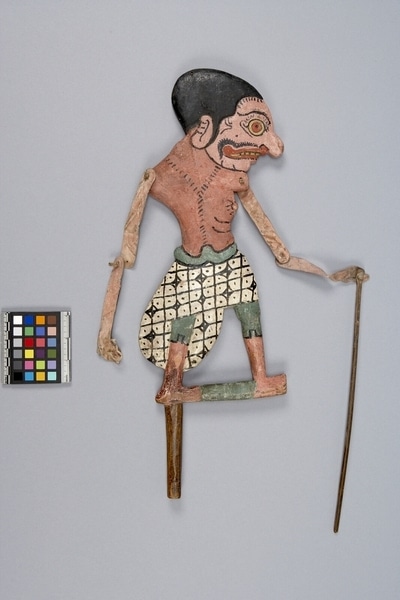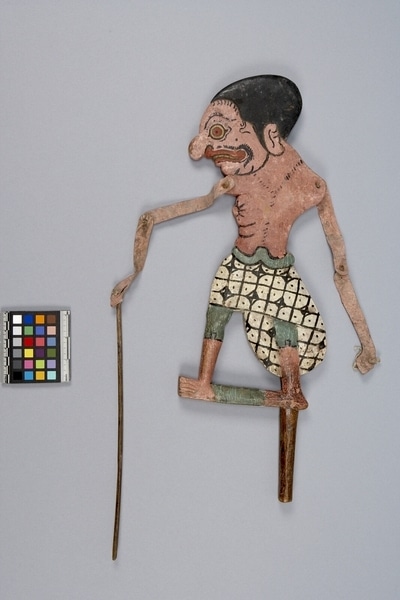Shadow Puppet Item Number: Ib361 from the MOA: University of British Columbia


Description
Two-dimensional humanoid male, painted on both sides. Jointed arms tied to shoulders and at palm of hand to right to controlling rod. Rod to other hand missing. All flesh pink (face, body, arms). Hair black. Face with blunt nose, wide bulging eyes with red irises, red lips and exposed teeth. Moustache, eyebrows, and other details in black. Chest with black dotted 'y' pattern. Skin contoured to right. Green undergarment with belt and black and white patterned skirt. Feet bare, legs apart.
History Of Use
Javanese puppetry as an art form probably developed by the 11th century. Wayang klikit puppetry is a minor form of shadow theatre. Originally the plays depicted Javanese mythology, but after contact with India the Hindu epics, Ramayana and Mahabharata, became predominant in the cycles, which comprise about 200 plays. A dalang (puppet master) performs the plays to celebrate important occasions, usually in three acts, with vocal and instrumental accompaniment. Typically they serve a moral and religious purpose. Although the custom varies, men typically observe the plays on the dalang's side of the screen, thus directly partaking of the spiritual elements of the drama. Women and children are excluded, watching only the shadows from the opposite side of the screen. Each puppet's character is represented by its appearance and placement onstage; good characters are placed to the right, evil to the left. Buta (demons) are indigenous additions to the wayang, providing the dalang with more adversaries to the protagonist(s). They are always portrayed as foreigners. Unfortunately, there are few accepted forms; many are idiosyncratic to their creator. This puppet seems less than traditional, but may fulfill the various roles played by almost any demon.
Iconographic Meaning
Each puppet is characterized by it's wanda, a Javanese word which describes the specific mixture of elements of size, form, colour, ornamentation and carving. Colour and position of face and eyes, stance, and exaggerated features indicate an aggressive character. Red irises, lack of headdress, and general ugliness suggest a demon or buta, although an particular character cannot be determined.
Cultural Context
Theatrical performance.
Item History
- Made in Java, Indonesia
- Owned by Tradewind Antiques before March 15, 1983
- Received from Museum of Anthropology Shop Volunteers (Funding source) and Tradewind Antiques (Seller) on March 15, 1983
What
Who
- Culture
- Javanese
- Previous Owner
- Tradewind Antiques
- Received from
- Museum of Anthropology Shop Volunteers (Funding source) and Tradewind Antiques (Seller)
Where
- Holding Institution
- MOA: University of British Columbia
- Made in
- Java, Indonesia
When
- Ownership Date
- before March 15, 1983
- Acquisition Date
- on March 15, 1983
Other
- Condition
- poor
- Accession Number
- 0886/0095